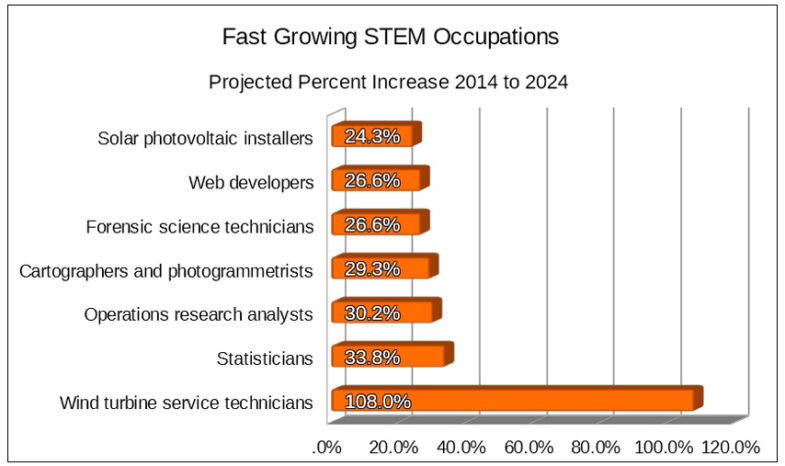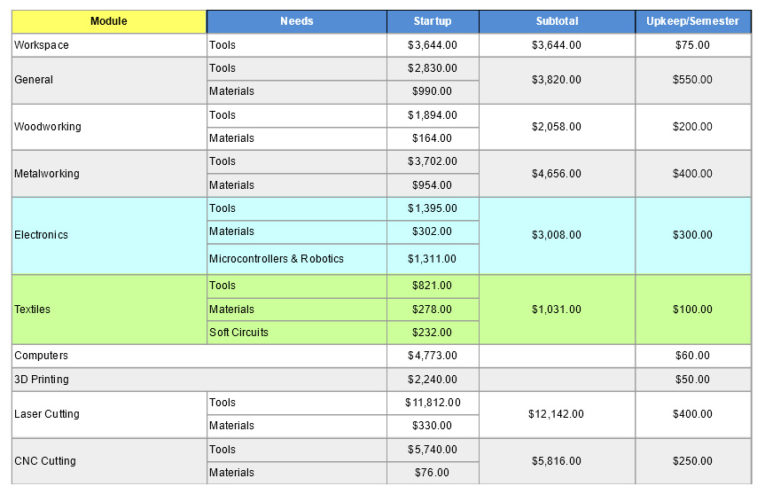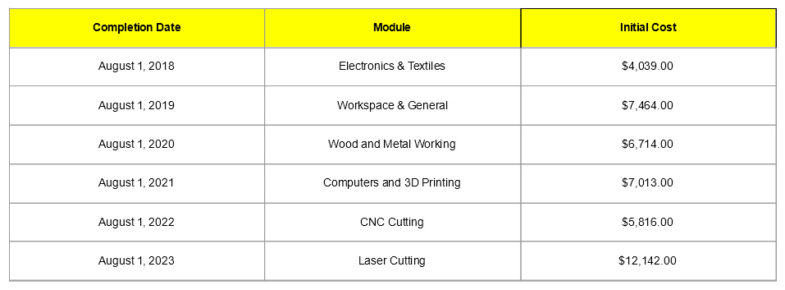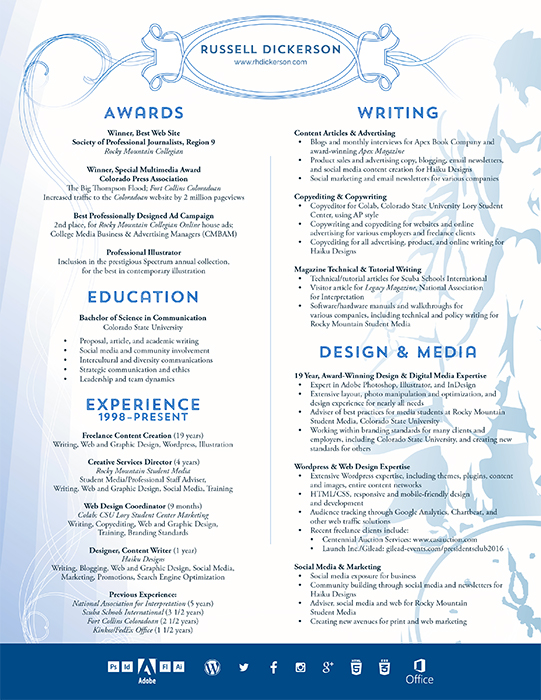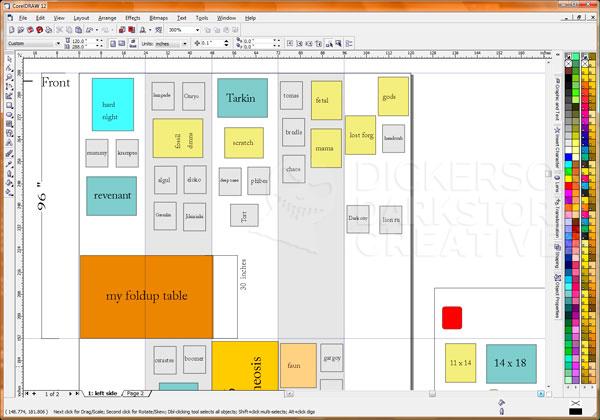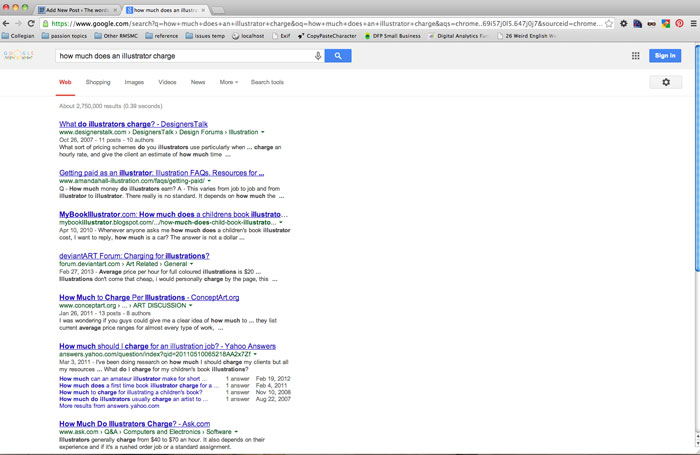This grant proposal was developed through the coursework for my Bachelor of Science in Communications degree from Colorado State University. It is based on real information for a makerspace grant. The original project spans many pages, and an edited, APA-formatted PDF version appears below.
Executive Summary
This proposal explores the expansion of the makerspace at Windsor High School, and the grant funding that can begin the process. Makerspaces increase practical learning opportunities for students, providing students and faculty with a unique combination of formal and informal learning practices. Makerspaces are hands-on centers for learning not just about a subject, but getting students involved directly with how science, technology, engineering, art, and math can be practically used. Students will be able to design their own unique creations, and hold a final physical object in their hands. The theory students learn in classes gives way in a makerspace to reality, important practical knowledge that students can use as they move on to college and the working world.
A planning process across multiple years is important to help the Windsor High School makerspace grow from a single computer and 3D printer, up through electronics and textiles, through to the final technological marvel respected throughout the district and state. In the first year, initial grant funding would help the makerspace expand into electronics and textiles, at approximately $4,000. Electronics and textiles would not drastically increase the makerspace footprint in the library, and would provide and expanded vision of a makerspace to more students.
Funding the first small stage would based on a grant from the Lowe’s Toolbox for Education program. The program, offered twice yearly, is specifically designed this year to help educational institutions with STEM-related projects. With grants available up to $5,000, the Lowe’s Toolbox for Education grant would be perfect to help Windsor High School expand the makerspace.
Introduction
This proposal provides information on offering and expanding the makerspace at Windsor High School. The proposal takes the stance of increasing practical educational opportunities for students of the school through a makerspace. It includes a planning process that builds the makerspace from its origins as a single computer and 3D printer, through electronics and textiles, through to the final stage of the broad features of a fully operational makerspace and technological marvel. Funding the initial stages would come through grants, particularly the first small stage based on a grant from the Lowe’s Toolbox for Education program.
Overview of Makerspaces
In the last decade, the terms “maker” and “makerspace” have entered the collective consciousness. Museums, libraries, schools, and independent organizations now offer makerspaces worldwide, bringing technology together with an eager community. Fascinating new technologies such as 3D printers and scanners, laser cutters, and software, combined with traditional knowledge like woodworking and metalworking, allow anyone to create nearly anything their heart desires.
But the idea of makerspaces, and indeed making anything, is not a new concept at all. Humans have been making things as individuals for thousands of years, and every day people around the world are creating new pieces of art, writing, and items needed in their daily lives through their ingenuity. In many ways, calling someone a “maker” or using a “makerspace” is just a new, fancy term for those people who want to create things themselves, and having a space to work in.
From an institutional standpoint, making has been around for centuries. Quilting societies date back to the 19th century, and art and crafts flourished in public libraries in the 1930s (Oliver, 2016). Libraries and educational programs have promoted hands-on learning for many years, especially in art and media both during and after school (Oliver, 2016). The intent of the maker movement is to provide the opportunity for students, and anyone else, to use the concepts of creating new ideas and products without having to rely on mass production.
Modern makerspaces vary in the activities offered, and depend on the amount and type of space available. With makerspaces as large as a Walmart, and as small as a simple table in the corner of a library, the idea of a makerspace varies widely. The maker movement is built on a do-it-yourself model, and is often characterized by the high technology involved in many of the publicized spaces (Koh & Abbas, 2015). Participants not only have the opportunity to design an item, they can turn those designs into real objects using 3D printers and other technology (Koh & Abbas, 2015). The advantage of a makerspace is having a place that offers tools and materials that many do not have access to, everything from power tools, to sewing machines and soldering irons, all the way up to expensive computer controlled laser cutters and Computer Numerical Control (CNC) routers (Koh & Abbas, 2015). The ideas and concepts are endless, and only depend on the size of the makerspace, funding, and maker imagination.
Makerspaces allow for freedom of creativity and knowledge, and within the makerspace a community of like-minded people can learn new ideas and come to rely on each other. Windsor High School has taken a great first step by offering a new, small makerspace with a 3D printer, opening the door to a new and exciting program (Windsor High School, n.d.). With a small grant for funding, Windsor High School can continue the journey by taking the next step into the maker movement and expanding the program.
Why offer or expand a makerspace?
Makerspaces share similarities with movements from the past, including general shop classes and internet entrepreneurship, but with some important modern differences that could put students ahead of their peers. Former Wired Magazine editor-in-chief Chris Anderson called the maker movement a “new industrial revolution,” based on differences with historical movements (Halverson & Sheridan, 2014). Anderson specified three important distinctions with the maker movement from others: standard design practices throughout the maker community, the open culture of sharing everything about projects online and with other makerspace participants, and the common use of similar computer-based tools (Halverson & Sheridan, 2014). A major difference with previous movements is that makers create physical objects from their work, instead of merely computer output or general ideas (Halverson & Sheridan, 2014). For students, makerspaces are not just a place to learn, but provide ways to literally produce what they have learned through advanced means.
Different types of makerspaces allow for varied projects, not just advanced technology but traditional engineering and science as well. Makerspaces can include 3D printing and laser cutting using advanced computer software, but they are also places where someone can build a wooden table by hand. Makerspaces of vastly different sizes can offer woodworking, metalworking and forging, electronics and robotics, casting and molding, and advanced digital fabrication (Oliver, 2016). Each makerspace can offer many choices, or concentrate on just one or two. Some makerspaces prefer working face-to-face in a warehouse environment, other makerspaces are quiet digital spaces in the corner of a library or school, and both present ways of combining old and new methodologies (Halverson & Sheridan, 2014). Makerspaces do not have to be linked with high technology either. Work by makers often starts, and sometimes stays, with unique cardboard constructions, and knitting, gardening, and craft work have been popular in some makerspaces (Daley & Child, 2015). Those opportunities are important not only for a makerspace to thrive, but add an exciting energy for education-based makerspaces.
The maker movement defined makerspaces with important ideas in mind. Oliver (2016) gathered those qualities in a list that explains the importance and value of makerspaces (p. 161):
- Self-directed according to student interests (Educause 2013; Wyld 2014);
- Supportive of curious play and creating with tolerance for failure and retrial (Britton 2012; Kurti et al. 2014a; Wyld 2014);
- Encouraging of peer collaboration and sharing skills between experts and novices (Abram 2013; Britton 2012; Kurti et al. 2014a; Wyld 2014);
- Physically-sited and open for ongoing project work that is both scheduled and unscheduled (Abram 2013; Educause 2013);
- Well-stocked with salvaged/sourced materials or common equipment for project work (Abram 2013; Wyld 2014);
- Drivers of the maker movement include cheap technology, open source hardware and software, and globalization, with different players acting in the maker ecosystem—beginners, collaborators, and market innovators (Hagel et al. 2014).
These qualities highlight the importance of material support and critical thinking within a makerspace, perfect for an educational environment. A great makerspace means excellent energy for students, aligning with their studies and teaching them through making to use thought and reason, not simply retelling facts they were told in class (Smay & Walker, 2015). Students do not simply create a report of information for a class, they use real-world knowledge and skills to produce the exact things they were learning about.
Producing items in a makerspace that had been only theories in a class highlights the importance of practical learning, and the connections between formal and informal learning. Students in a makerspace are not limited by the strict guidelines and course plans in formal education, but can openly discuss the intricacies of how, who, and what practical learning is (Halverson & Sheridan, 2014). Students can find what they are interested in and build expertise for it, and link their classes and makerspace to their plans for future careers (Koh & Abbas, 2015). Particularly with the rapid pace of technological changes, regular classes might only teach a student about the current programming language in use. As fast as technology moves, that programming language could be useless by the time they leave high school. A makerspace is designed to give practical experience to a student not just about a specific coding language, but how to find solutions to software issues based on the type of program and family of coding options (Craddock, 2015). In a makerspace, students do not simply learn one programming language, they learn the far more useful understanding of how to find the correct coding language for the task and implement it (Craddock, 2015). Students build expertise and knowledge, and at the same time they build the capacity to understand putting the right skills in play (Craddock, 2015). Changing methods and technologies remain true for many of the projects available in a makerspace, from printing and fabrication technologies to different metalworking techniques, and the value for students to learn adaptability to change is one of the strongest advantages of a makerspace.
Learning new methods and being adaptable to change helps both the student and the makerspace community. Students with increasing knowledge become sources for their peers, and over time teachers and administrators need to be involved on a decreasing basis (Craddock, 2015). Students learn vital community skills by working together, and collaboration of different social groups and types of thinkers adds to the unique experience (Craddock, 2015). Student collaboration in a makerspace becomes the perfect experience for students as they move on to working with teams in college and their future careers, as they learn to work together to build the expertise of the entire community.
STEAM/STEM opportunities.
In the 21st century, science, technology, engineering, and mathematics (STEM) programs have become important to schools, and makerspaces excel in offering practical STEM knowledge to students. Educational institutions often have STEM goals to meet, and a makerspace can help to reach those by increasing opportunities for all students (Halverson & Sheridan, 2014). Since makerspaces provide opportunities to all levels of users, students at all economic levels can take advantage of technology and materials they might not otherwise have access to, and help the school reach their STEM goals even faster (Halverson & Sheridan, 2014). Reaching those goals means more opportunities for students in the school, and a step forward towards a career in STEM-related positions.
Makerspaces offer practical knowledge for students that can help them gain experience for future STEM-related jobs. Many positions require a knowledge of computers, and makerspaces offer a wide range of opportunities to learn how to code, build apps and websites, learn video and podcasting, even working with digital files for 3D printed items (Goodman, 2014). Figure 1 shows several STEM-related positions with at least a 24 percent expected increase in job openings through 2024. Many of the projects in a makerspace perfectly fit the knowledge for those positions, opening up new careers for students.
Many programs also add another element that makerspaces can influence, art, the “A” in the often-used STEAM acronym. Studies show that scientists and innovators of technology are typically non-linear thinkers, including a number of Nobel Prize winners, who use both cognitive and creative methods for the best results (Kurti, Kurti & Fleming, 2014A). Makerspaces, much like the beginnings of the Windsor High School space, often have advanced technology that requires both an artistic sense and a technical mastery that provides a perfect solution for the best innovative students.
Combining Makerspaces and STEAM Education
By using makerspaces alongside traditional coursework, Windsor High School will be able to bring participation more thoroughly into a student’s experience. As with all things, however, there are challenges to using makerspaces, and these possible problems would need to be addressed with thorough planning. Despite those concerns, the maker movement is an important asset to the future of education, and has many positive effects for both students and the school. Students learn the positive aspects of making things and working within a community, and they also learn through trial and error how to solve their own problems, an important lesson growing into adulthood (Halverson & Sheridan, 2014). Increased STEAM goals and achievements are important, and makerspaces help students and staff to work towards personal and professional goals and towards a strong future.
Possible negative effects of educational makerspaces.
While the makerspace at Windsor High School will be overwhelmingly positive, there are a few negative considerations that need to be addressed. Each potential issue has solutions that with work and planning can be kept under control. From personal and financial standpoints, each should be considered carefully so that no further issues will appear in the future.
Makerspaces are filled with various tools and machines, depending on the space, and there will always be potential concerns for the students and faculty that use the space. Technology, particularly with printing both traditionally and in 3D, raises legal and ethical issues based on proper content, intellectual rights and piracy, privacy of students, and using public information (Crumpton, 2015). Makerspaces also feature a variety of machines with moving or hot parts, and safety, access, liability, and the legal use of equipment both for certain age requirements and potential misuse must be considered through new policies (Crumpton, 2015). Even smaller items that only have a slight chance of injuring a student, such as a battery or LED bulb, would require some sort of release or liability remark prior to usage.
Educators might not be on board with a makerspace due to concerns about information and current knowledge. Teachers might not be used to teaching from either an informal or project-based side, and could choose not to let their students link with the makerspace (Oliver, 2016). Teachers are also under pressure to make sure their students can pass standardized tests, and may not have the time to teach students or themselves how to learn new procedures and lessons (Oliver, 2016). With classes planned out specifically to stay on track, there may not be the opportunity to work a makerspace project into the classroom setting.
Students may have their own concerns about being a part of a makerspace. The MAKE organization and Make Magazine have been accused in the past of highlighting mostly white male participants in maker programs, and specializing only in electronics, vehicles, and robots (Halverson & Sheridan, 2014). Some consider the dominant culture of white males in the maker movement to be inaccessible to others, and makers who do not identify as such might not participate in what they feel are not inclusive programs (Halverson & Sheridan, 2014). Students might also feel that, by makerspaces becoming a formal part of school instead of a separate club, the institution might crush the innovation and creativity that are a typical part of the maker movement (Halverson & Sheridan, 2014). Students might opt out before the makerspace really gets moving, and never see the positive effects of the space.
Possible positive effects of educational makerspaces.
A makerspace in Windsor High School will have many positive effects on students, staff, and the entire school. Learning through practical knowledge and making things is the base of how people learn, and makerspaces provide this opportunity through open experiments, critical thinking, and the final production of a work (Halverson & Sheridan, 2014). Students learn valuable techniques and lessons informally away from the educational environment, and a makerspace brings that participation into the school for educators to adapt and grow with (Daley & Child, 2015). Combining formal and informal techniques helps teachers increase outcomes for students, and clears the way for more teacher-student projects and innovative curriculums in the classroom (Daley & Child, 2015; Oliver, 2016). The effect is overwhelmingly positive even outside of the makerspace, and can lead to more community efforts between students and faculty.
The community of students and faculty in a makerspace allows an exploration of different opportunities between disparate disciplines, and clarifies unique principles. Makerspaces encourage STEAM by mixing together aspects of all disciplines, putting the theories and ideas of each course of study to the test (Oliver, 2016). For example, a makerspace project could be used to engineer a trellis covered in a specific type of moss, designed to grow only on certain boards, to create a living checkerboard pattern. Students could sell the products in a fundraiser to further support the makerspace, even adding custom embroidered hats with the Wizard logo on them from another project of the school makerspace (Oliver, 2016). With a makerspace, designs can easily be swapped for others, specialized through makerspace tools and materials to fit a new perspective that mass produced items cannot match (Belbin & Newcombe, 2013). Projects like these not only combine different ideologies and disciplines together, they offer a unique, community-building means to encourage further makerspace use and support.
A makerspace can also provide more personal needs, and build future strengths through important lessons. Makerspaces are designed as open communities, with flourishing ideas and a safe community of supportive and noncritical participants (Koh & Abbas, 2015). A safe, supportive community is often what a student needs, and makerspaces provide a space where students can feel important and accepted. Those who cannot afford materials or tools on their own, or are not normally able to find someone with expertise, can come to a makerspace and be welcomed (Koh & Abbas, 2015). Students not only get technological and project information, they also learn important lessons about sustainability, as most makerspaces use take old products and reuse, fix, or recycle them into new creations (Daley & Child, 2015). Reusing and recycling is at the heart of many makerspaces, as it saves money and offers new ways to learn.
The Scope of Makerspaces and Potential Funding
Makerspaces vary greatly in size, scope, and intent, and it is important to move forward with the best plan in place. Investments in space, tools, and materials depend on what stage Windsor High School is ready for, and if the makerspace will be based on STEAM, art, technology, woodworking, or any combination of options. Understanding what Windsor High School teens want, need, what interests exist, and how to pull off a makerspace are all important considerations (Koh & Abbas, 2015). Gathering information on student interests can help, but a perfect time and exact set of tools will never happen at exactly the right time (Kurti, Kurti, & Fleming, 2014B). Building up a makerspace over time is the best plan, and understanding the costs involved at each stage helps to determine how and when Windsor High School will be ready for each step. Table 2 shows the approximate costs for different stages of a high school makerspace, from a general work area to offering a full CNC router and computer.
Best starting choice: electronics and textiles stage.
Since the Windsor High School makerspace has already started with a 3D printer in the library, the best course of action would be to continue on a smaller scale. With a library space, woodworking, metalworking, and other projects with loud noises and more shop-related experiences would not match the current plan. Adding electronics, such as robotics and small computer-part projects, along with textiles such as embroidery and sewing machines, would be a much more economical and environmental method to move forward with. Table 2 shows these elements highlighted, with costs shown. More specific costs and makerspace information is available in Appendix B. These new tools and materials would add a new dimension to the Windsor High School makerspace, and could be easily funded through a small grant. The plan would then be to set goals for further additions to the makerspace in future years, and Table 3 offers a plan for the entire makerspace and its needs.
Funding opportunities.
To avoid using school funds, a grant is recommended to fund the next stage of the makerspace. Grants are common when it comes to makerspaces, as one survey reported that 65 percent of polled makerspaces were funded through grants and a mere 36 percent were funded through an organization’s budget (Craddock, 2015). The Fayetteville Free Library in New York started a makerspace through grants, receiving a $10,000 grant through the Contact Summit and another $20,000 grant through a New York state construction grant (Belbin & Newcombe, 2013). A good grant fit for the next stage of the Windsor High School makerspace is the Lowe’s Toolbox for Education grant, featuring smaller grants up to $5,000.
Grant Source: Lowe’s Toolbox for Education
Reasons to use the Lowe’s Toolbox for Education
Since the combination of the Electronics and Textiles stages add up to $4,039, and the Lowe’s Toolbox for Education grant is typically between $2,000 and $5,000, this grant would fit perfectly with the makerspace needs, and possibly include enough money for upkeep and supplies through the first year. Windsor is also equally between three different Lowe’s retail stores, which should help the local profile with the organization. Below is further information about the grant, and complete information about Lowe’s is available in Appendix A.

Types of projects funded.
Lowe’s Toolbox for Education grants fund a variety of projects throughout the year. Funding preferences are for projects that will have a permanent community impact, encourage parent and community involvement, and increase community spirit (Lowe’s FAQ, n.d.). The 2016-2017 application also specifically asks for projects that will enhance STEM programs and education, particularly technology, facility, and safety upgrades and improvements (Lowe’s FAQ, n.d.). The grant fits perfectly with the needs of the Windsor High School makerspace, a project driven fully by STEM and education.
Overview of grant amounts and number of yearly proposals.
Lowe’s provides a limit per school, per year, and for overall giving. Grants between $2,000 and $5,000 are given to individual programs, with Lowe’s donating up to $5 million to 1,000 different schools in a school year (Lowe’s FAQ, n.d.). Grants must fall within the individual grant range, or they will not be considered. Lowe’s limits each application cycle to 1,500 applications, and closes the cycle when that limit is reached (Lowe’s FAQ, n.d.). There are other Lowe’s grant programs that feature greater funding amounts, but they are beyond the scope of this proposal.
Specific funding criteria.
As a public K-12 school, Windsor High School is eligible for the Lowe’s Toolbox for Education grant. Grant applications are accepted twice yearly, in the spring and fall, with deadlines posted on the Lowe’s website (Lowe’s Open House, n.d.). Lowe’s awards grants to communities with a local Lowe’s store, but since a distance is not required Windsor should fall into that designation (Lowe’s CR, n.d.). Funding is not meant for various uses such as memorial campaigns, continuing education for faculty, or travel expenses, which should not effect the makerspace plan (Lowe’s FAQ, n.d.). Otherwise, the grant seems to be quite open for schools and other organizations to apply.
Conclusion
The maker movement and makerspaces have changed the way the students learn, and the combination of formal and informal learning is vital to education in the 21st century. This proposal provided information on expanding the makerspace at Windsor High School. To increase practical educational opportunities for students of the school, an expanded makerspace and planning process was proposed that builds the makerspace from its current simple status to a fully operational makerspace. Funding the initial stages would come through grants, particularly the first small stage based on a grant from the Lowe’s Toolbox for Education program.
References
- Belbin, N., & Newcombe, P. (2013). Fab labs at the library. The Education Digest, 78(7), 65-68.
- Bureau of Labor Statistics. (n.d.). Fastest growing occupations. Retrieved from https://www.bls.gov/emp/ep_table_103.htm
- Craddock, I. L. (2015). Makers on the move: A mobile makerspace at a comprehensive public high school. Library Hi Tech, 33(4), 497-504.
- Crumpton, M. A. (2015). Fines, fees and funding: Makerspaces standing apart. The Bottom Line, 28(3), 90-94.
- Daley, M., & Child, J. (2015). Makerspaces in the school library environment. Access (Online), 29(1), 42-49.
- Goodman, A. L. (2014). Equipment and software. Library Technology Reports, 50(6), 16-28,2.
- Halverson, E. R., & Sheridan, K. M. (2014). The maker movement in education. Harvard Educational Review, 84(4), 495-504,563,565.
- Koh, K., & Abbas, J. (2015). Competencies for information professionals in learning labs and makerspaces. Journal of Education for Library and Information Science, 56(2), 114-129.
- Kurti, R. S., Kurti, D., & Fleming, L. (2014A). The environment and tools of great educational makerspaces. Teacher Librarian, 42(1), 8-12.
- Kurti, R. S., Kurti, D., & Fleming, L. (2014B). Practical implementation of an educational makerspace. Teacher Librarian, 42(2), 20-24.
- Lowe’s CR. (n.d.). Frequently asked questions. Retrieved from https://1g0r7s45brd833po5f1d5yyb-wpengine.netdna-ssl.com/wp-content/uploads/2016/02/CSR-FAQs.pdf
- Lowe’s FAQ. (n.d.). Frequently asked questions. Retrieved from http://toolboxforeducation.com/faq
- Lowe’s Open House. (n.d.). Apply for a grant. Retrieved from https://newsroom.lowes.com/apply-for-a-grant/
- Makered.org. (n.d.). High school makerspace tools and materials. Retrieved from http://makered.org/wp-content/uploads/2014/09/Makerspace-High-School-Makerspace-Tools-And-Materials-April-2012.pdf
- Oliver, K. M. (2016). Professional development considerations for makerspace leaders, part one: Addressing “what?” and “why?”. TechTrends, 60(2), 160-166. doi:http://dx.doi.org.csuglobal.idm.oclc.org/10.1007/s11528-016-0028-5
- Smay, D., & Walker, C. (2015). Makerspaces: A creative approach to education. Teacher Librarian, 42(4), 39-43.
- Windsor High School. (n.d.). Makerspace at WHS. Retrieved from http://whs.weldre4.org/cms/One.aspx?portalId=3055869&pageId=26506305
Appendix A
Information on Lowe’s and Lowe’s Foundations
All Lowe’s Foundations
Lowe’s features a number of different grant programs, from small grants starting at $1,000 to large grants up to $100,000. These include the Lowe’s Toolbox for Education grants program, Lowe’s Community Partners Grants, and Hometown Grants. For full information on each grant and Lowe’s overall giving program, visit https://newsroom.lowes.com/apply-for-a-grant/
Sample Lowe’s Toolbox for Education Application
Featured on the Lowe’s website is a sample grant application for the Lowe’s Toolbox for Education grant program. Sample information is included in the interactive PDF, so that users will know what answers Lowe’s is looking for. Download or visit the interactive PDF on their site at http://toolboxforeducation.com/resources/Lowes_TBFE_Sample_App_08-09.pdf.
Windsor Area Lowe’s Stores
There are a few Lowe’s stores in the immediate Windsor area. While the Lowe’s Toolbox for Education grants program is a separate system administered from Lowe’s corporate offices, information about the local stores could be beneficial for the grant and for further charitable contact directly with the stores.
- Front Range Village, 4227 Corbett Dr, Fort Collins, CO (970) 232-7910
- 1355 Sculptor Dr, Loveland, CO (970) 663-9910
- 2400 47th Ave, Greeley, CO (970) 506-2280
Appendix B
Maker and Makerspace Resources
The maker movement is a very broad one, with many resources online both specifically for educational spaces and generally for all makerspaces. Below are some of those resources, including the full dataset on predicted STEAM jobs in the future.
Full Bureau of Labor Statistics Employment Projections
The U.S. Bureau of Labor Statistics features an extremely large dataset of employment in 2014, and projections through 2024, that are briefly touched on in this proposal. For more detailed information, visit the full dataset at https://www.bls.gov/emp/tables.htm.
Make Magazine
Make Magazine is an important resource for the maker movement, and contains everything from makerspace plans, Maker Faire information, and projects. Visit their website at https://makezine.com/
Makerspace Lab Resources
Makerspace Lab Resources provides information for schools and other organizations entering the maker movement, and is also a supplier of many of the materials that may be needed in a makerspace. For more information, visit http://www.makerspacelab.com/white-lab-coats-for-kids-resources/
Makerspace Playbook and High School Makerspace Data
Maker Ed provides many resources for the maker movement, including plans for makerspaces, costs, proposal templates, material and tool lists, and much more. Brief information from Maker Ed’s High School Makerspace Tools and Materials resource (full version here) was used as two of the tables in this proposal, and the Makerspace Playbook was listed in several places online as a valuable resource in creating makerspaces.
Makerspace Products and Materials Lists
Makerspaces.com features a long list of potential products and materials that could be useful in various types of makerspaces. For more information, visit https://www.makerspaces.com/makerspace-materials-supply-list/.
